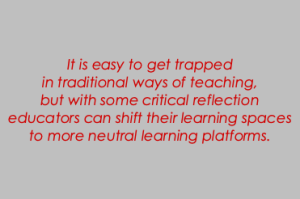By Christine Sensible-Wiseman
I’ve spent over a decade creating my analysis in community-setting grownup ESL lessons. I’ve discovered the trail to empowerment for newcomers considerably tough. College students face many obstacles, together with discrimination, racism, and the rising challenges of settling into a rustic the place English isn’t their first language. I’ve additionally realized that my very own positionality, in addition to the positionalities introduced in instructing supplies, can compromise college students’ talents to narrate and succeed. Which means that my very own concepts, and the concepts introduced in ready-made supplies, usually mirror the established order—not the everyday grownup ESL learner. So, what can we do about this within the classroom? There are two key methods educators can critically mirror on their instructing practices.
First, as a doctoral scholar, my main analysis centered on my positionality, which merely means how I see the world. Upon reflection, I observed that I unknowingly subscribed to what Freire (1970) calls the banking mannequin of training, which mirrors conventional instructing strategies. On this mannequin, the trainer stands and teaches on the entrance of the category whereas college students are passive recipients of the “almighty” information the trainer upholds. Fortunately, I’ve modified! Have you ever? Will you? Do you are taking the time to mirror in your instructing practices and think about the results of what and the way you train? Do you critically mirror on the instructing supplies you supply as studying instruments to college students?
Second, integration ought to mirror all cultures within the classroom. It is necessary for college students’ voices to be heard and revered within the class. At occasions, educators subconsciously confuse assimilation with integration. From my perspective, integration is a two-way avenue the place we study from one another, or what Freire (1970) calls “conscientização” (a Portuguese time period), which develops out of partaking in dialogue. That is additionally identified in English as ‘crucial social consciousness’ (Shor, 2009). Because of this, integration includes the power for college students and educators to adapt and alter. Do you invite others to share their information within the classroom? Do you view integration as a reciprocal act? Do the dialogues in your school rooms invite information sharing, or is there a one-way mentality brewing?
It’s simple to get trapped in conventional methods of instructing, however with some crucial reflection, educators can shift their studying areas to extra impartial studying platforms. This can improve pathways to empowerment for newcomers. As educators, we have to begin making these adjustments by ourselves first and questioning what it’s we’re instructing and why.
What steps do you are taking to unravel disempowering practices within the classroom?
Freire, P. (1970). Pedagogy of the oppressed. The Continuum Worldwide Publishing Group Inc.
Shor, I. (2009). What’s crucial literacy? In A. Darder, M. P. Baltodano, & R. D. Torres (Eds.), The crucial pedagogy reader. Routledge
Dr. Sensible-Wiseman is captivated with uncovering methods to foster social justice. They imagine that instructing and studying areas ought to allow lively and equal membership in society. They’ve been instructing ELL for over 20 years. As well as, they’re a self-proclaimed “life learner” and just lately defended their PhD thesis. Dr. Sensible-Wiseman is happy to attach with like-minded professionals, so be at liberty to contact them!
